Using an Automated Mixer to Prepare Alginates, Dental Stone, and Impression Materials
Alginate-based impression materials and dental stone have come a long way since their use in the early days of dentistry. Some of the earliest known impression materials were made of plaster. Starches, gums, and chemicals were added to improve the handling and setting properties of the plaster. Flavoring agents were also added to improve the taste, but did nothing to improve the unsettling chalky feeling that was often left in the mouth after removal of the impression tray.
In the 1930s, metallic-oxide pastes were formulated based on zinc oxide/eugenol combinations. The taste of eugenol-based impression materials is extremely bitter because one of the main ingredients is undiluted clove oil, which is so powerful that adding pleasant flavors does nothing to improve the taste.
Elastomeric impression materials are a more recent addition, appearing in the 1940s and 1950s, and are the basis of today’s vinyl polysiloxane (VPS) materials. Elastomeric materials are separated into three chemical types: polysulfides, polyethers, and silicone-based. Elastomeric impression materials are typically supplied in two tubes: one tube contains the prepolymer and the other contains the reactive/catalyst agent. When the two are combined, a chemical reaction takes place that results in a hardening of the material. Currently, a mix of polyvinyl (essentially “plastic”) and silicone-based formulations is favorable for virtually all impression procedures because of its excellent material properties.
Dental stone, also known as gypsum, has also seen many improvements since its introduction to dentistry in the mid-1700s. Plaster was also the first material used for making dental casts or stone models (as they are often called). The problem with plaster was its brittleness and tendency to crack, chip, and flake. Gypsum, a mineral found commonly in nature, was discovered to have properties similar to plaster, but was much more durable when cast and hardened. Commercial quantities of gypsum are found naturally in several places throughout the world, including Germany, Italy, England, Ireland, and Canada. In the United States, natural gypsum reserves are found in New York, Michigan, Iowa, Kansas, Arizona, New Mexico, Colorado, Utah, and Nevada.
The first gypsum-based dental stone was patented in 1933. It was considered a high-strength plaster made by calcining gypsum under steam pressure. The resultant powder was given the trade name Hydrocal® (United States Gypsum Company, Chicago, IL) and consisted of dense, regularly shaped, nonporous cuboidal crystals. These crystals became the prime ingredient in what is known today as type III dental stone. Type III dental stone is widely used in making casts and molds requiring high crushing strength and abrasion resistance. But a more durable dental stone was still sought and, in 1952, a process was developed in which gypsum was boiled in a 30% solution of calcium chloride. This process produced larger and denser crystal formations than those found in type III materials—thus type IV dental stone was born.
THE NEED FOR AN EFFICIENT MIXING PROCESS
Dental practitioners know that something as simple as mixing can have a profound effect on the outcome of an impression or stone model. When mixing impression materials and alginates, it is important to ensure not only a smooth, homogeneous mixture, but also one that incorporates the least amount of air into the material. Studies have shown that alginate impression materials mixed with a mechanical mixer possess improved elastic recovery and compressive strength compared to those mixed by hand, as well as improved gel strength as a result of the decrease in air bubbles in the set material.1,2 Air bubbles can produce voids in the impression that affect the accuracy of the model, often resulting in the need to remake the impression. Likewise, improper mixing of dental stone can lead to air bubbles that create holes in the stone. Also, when the stone hardens, trapped air will compromise the integrity of the study model by creating thin spots that easily crack or chip with routine handling.
AUTOMATED MIXING
Alghamix, by Zhermack Inc (Eatontown, NJ), is a two-speed automated mixer for use with alginates, silicone impression materials, and dental stones (Figure 1; Figure 2; Figure 3; Figure 4). It simplifies the preparation of these materials by optimizing the setting reaction, thereby speeding up setting times. The low-speed setting is for preliminary mixing of water and powder, while the high-speed setting facilitates energetic final-phase mixing, resulting in a smooth, uniform, fully integrated, and bubble-free mixture. Additionally, the bowl spins at a constant speed that can reduce mixing time by as much as 30%, thereby enhancing productivity. The ergonomic positioning of the Alghamix’s mixing bowl is designed for user comfort that results in enhanced operator efficiency and less physical impact and stress on the clinician’s shoulder, elbow, and wrist. Mixing discs are also available to faciltate the blending of non-aqueous elastomeric impression materials such as polysulfides, silicones, and polyethers. For these materials, the bowl is easily removed and a flat-surface mixing disk is snapped into place (Figure 5; Figure 6; Figure 4; Figure 8).
In dental offices and laboratories that experience the need to mix a high volume of materials on a daily basis, the use of an automated mixer can help reduce the chance of repetitive stress injuries to the clinician, as well as improve the working properties of the materials.
References
1. Frey G, Lu H, Powers J. Effect of mixing methods on mechanical properties of alginate impression materials. J Prosthodont. 2005;14(4):221-225.2. Inoue K, Song YX, Kamiunten O, et al. Effect of mixing method on rheological properties of alginate impression materials. J Oral Rehabil. 2002;29(7): 615-619.
This article was written by Marty Jablow, DMD. Dr. Jablow maintains a practice with the Green Street Dental Group in Woodbridge, NJ.
For more information, contact:
Zhermack Inc
877-819-6206
www.zhermack.com
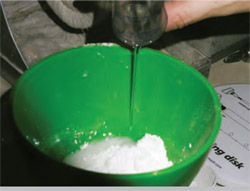 | 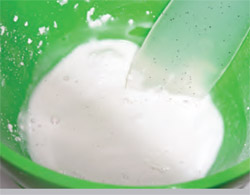 | |
| Figure 1 Powder and water are added to mixing bowl. | Figure 2 Low speed is used for preliminary mixing. | |
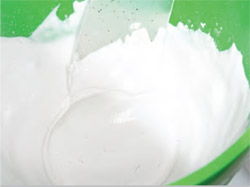 | 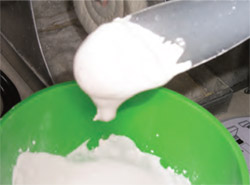 | |
| Figure 3 High speed is used for energetic, smooth, final-phase mixing. | Figure 4 Final product is homogeneous and bubble-free. | |
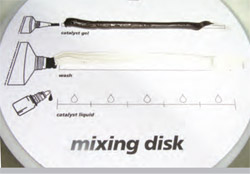 | 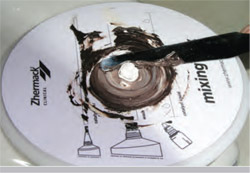 | |
| Figure 5 Templated mixing disk makes it easy to extrude the proper amount of catalyst and wash material. | Figure 6 Knife-edge spatula is held in place while disk spins to combine materials. | |
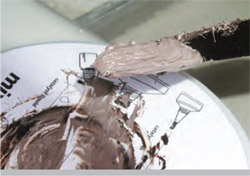 | 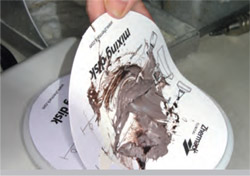 | |
| Figure 7 Fully mixed and ready for use. | Figure 8 Easy clean-up. Simply remove disk and discard. |



